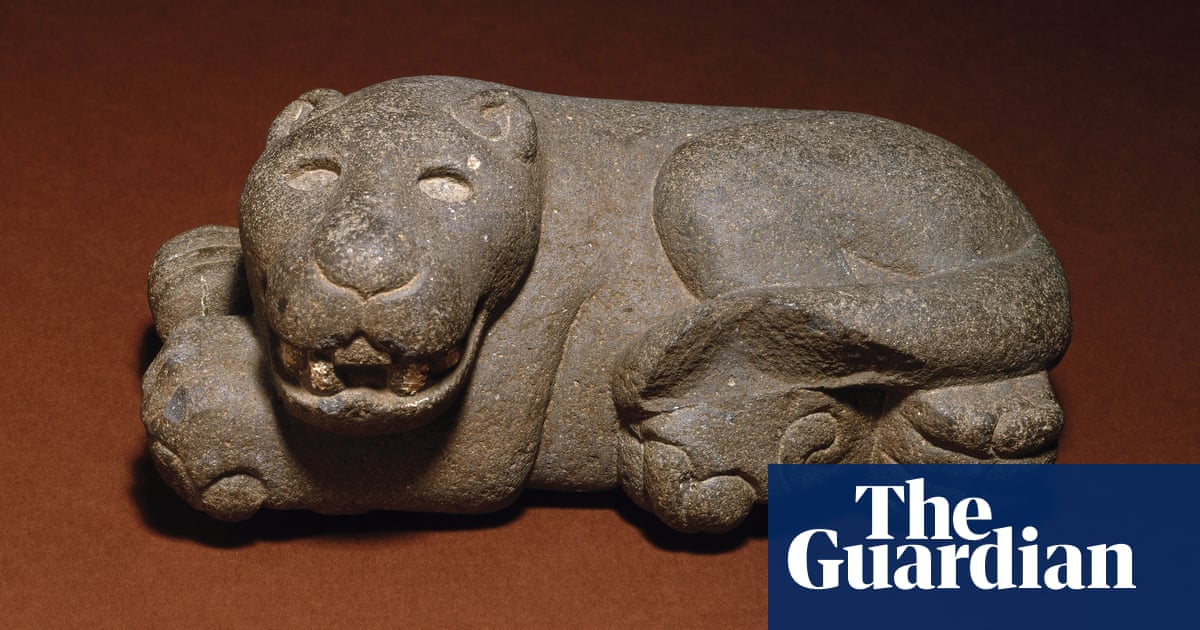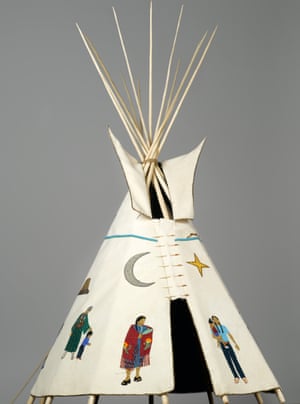In a new exhibition at the Brooklyn Museum, art from the past 2,800 years is used to explain the environmental impact on Indigenous people

In 2016, Barack Obama declared the Bears Ears in Utah, a pair of buttes towering above Cedar Mesa, a national monument.
At the time, it was considered a victory for Native American tribes and land conservationists, as the sacred area is home to archaeological sites, including an ancient cliff.
Donald Trump has since minimized Bears Ears by 85%. Just last month, he finalized the plans to allow mining and drilling. Some say its the current administration ignoring Indigenous voices.
Its a timely issue, and one that ties into a new exhibition at the Brooklyn Museum in New York. Climate in Crisis: Environmental Change in the Indigenous Americas features more than 60 artworks from the past 2,800 years; from ancient sculptures to handmade quilts, jewelry and a teepee. It looks at the history of colonization and the exploitation of natural resources.
Its a refresh of the arts of the America collection in a way that we could talk about the current climate crisis, and its impact on Indigenous people, said Nancy Rosoff, the curator. These are the greatest hits of our collection, in terms of arts from the Americas and were looking at them through the lens of climate change and its impact on Indigenous people.
From melting icecaps to wildfires and droughts, the heart of the exhibition is the difference in world views between native and non-native people.
Native people view their surroundings and world view as inter-related, the world as one organism, said Rosoff. Whereas Euro-Americans view humans as paramount importance and privilege over the environment and everything else.
By including Indigenous world views into the conversation, she added, it will make people more aware of how important they are; promoting environmental justice and supporting native cultures.

The exhibition highlights the protests surrounding the
Looking at these two serious issues of government sanctioned development projects that are impacting Indigenous homelands and Indigenous survival, is what Indigenous people are grappling with every day of their lives, said Rosoff.
The artworks span from North America through Central America and South America, including sections on the Mississippi river valley, the north-west coast, the south-west, Mexico and Guatemala, among other regions.
Some of the works on view include late 19th-century Kachina dolls by She-we-na (Zuni Pueblo) artists in New Mexico, as well as a whale made of cedar from a Kwakwakawakw artist in British Columbia.
Theres also an engraved whale tooth from Alaska, created by an unknown artist, alongside a pair of towering cedar house posts gracing the entranceway of the gallery, by an unknown Heiltsuk (Bella Bella) artist. Peruvian jewelry made of beetle wings are shown alongside figurines of a nobleman by a Mayan artist, found in Mexico.
One of the more recent works is a 2010 teepee made by Santa Fe-based artist Teri Greeves, who uses beadwork to detail family portraits into an artwork called 21st Century Traditional: Beaded Tipi. Its a perfect way to talk about the importance of the teepee as part of plains identity, said Rosoff. In the 21st century, its still an important part of tribal identity.

Meanwhile, Brazils
The most recent artwork on view is a hand-woven basket made from 16mm film, created by Mikmaq and Onondaga artist Gail Tremblay. The film used to make the basket comes from a 1967 documentary of an Inuit family in Canada, where actors pretended to live in Igloos and travel by dogsled. Its the ironies of film of portraying Inuit life that doesnt exist anymore, said Rosoff.
On the museum wall, theres a map of tribes and the areas they inhabit, which are different than the country maps were accustomed to. For every region, we talk about Indigenous people who lived there, the impact of European colonization, and the ways Indigenous people have relationship to natural world, she said.
The voices of Indigenous activists are included on the walls, too, which highlight some of the work thats helping protect the planet. There are quotes from Berta Cceres, an environmental activist from Honduras who defended the Indigenous Lenca people until she was assassinated in 2016.
We think of environmental defense funds, their own activists are on the front lines, theyre being murdered at an unprecedented rate in central and South America, said Rosoff.
Another voice included is Zuni tribe member Jim Enote from New Mexico, who said that Bears Ears is a place to pay respect to ancestors. The people that lived there and built the structures there and carved on the cliffs there, he said. The blood of those people is in my veins.
The exhibition features a quilt created by Gina Adams, who embroiders words from treaties into quilts. Its part of the artists Broken Treaty Quilts, where the artist sews together injustice into an object of comfort.
This artwork is a way to talk about longer history of how the US has treated native people, said Rosoff. Were still violating treaty rights, whether its the Dakota access pipeline or violating sacred homeland or national monuments, it goes on and on.
The US government coerced over 370 tribes to sign treaties, native people were forced onto reservations starting in the 1860s so land could be taken, turned into lots, bought and sold, over 90 million acres of native land, she added.
Many of the ancient objects on view from Central and South America offer a window into how communities connected to the natural world, and the supernatural. The exhibit includes a Mayan bowl made of ceramic that dates back to 350 BC, an Aztec sculpture of a jaguar made from volcanic stone and a golden plaque to honor a crocodile deity from Panama.
Theyre viewing these groups as not even existing anymore, she said. We wanted to use these objects as another way of looking at issues affecting Indigenous people today.
-
Climate in Crisis: Environmental Change in the Indigenous Americas is on show at the Brooklyn Museum until 10 January 2021
Original Article : HERE ;
from AllAbout https://allabout.pw/how-artwork-shows-the-impact-of-climate-crisis-on-indigenous-americans/
No comments:
Post a Comment